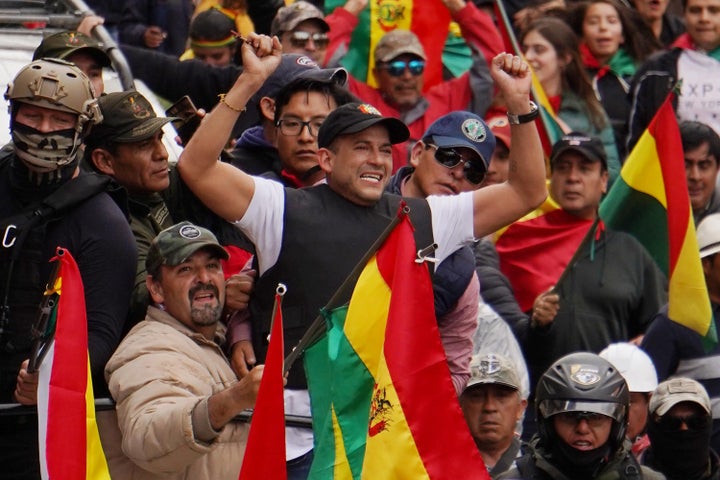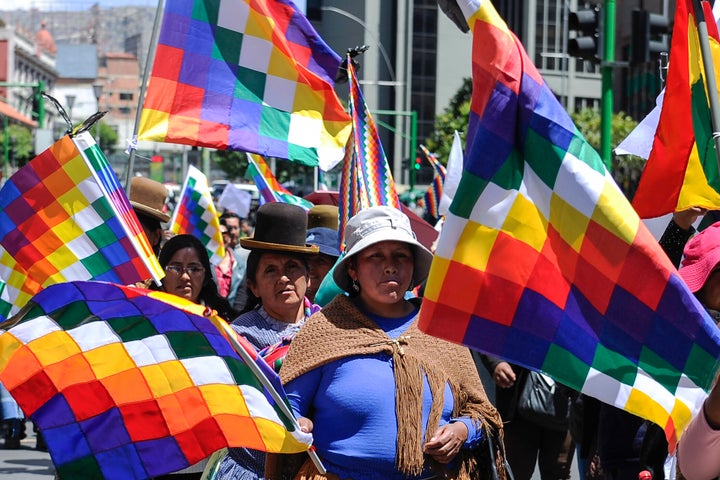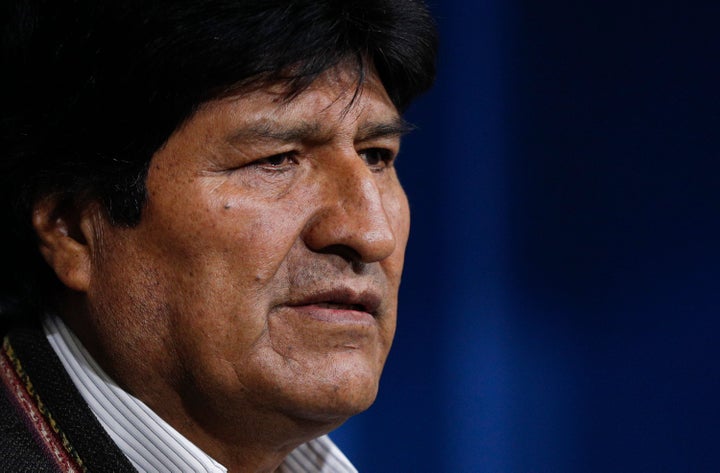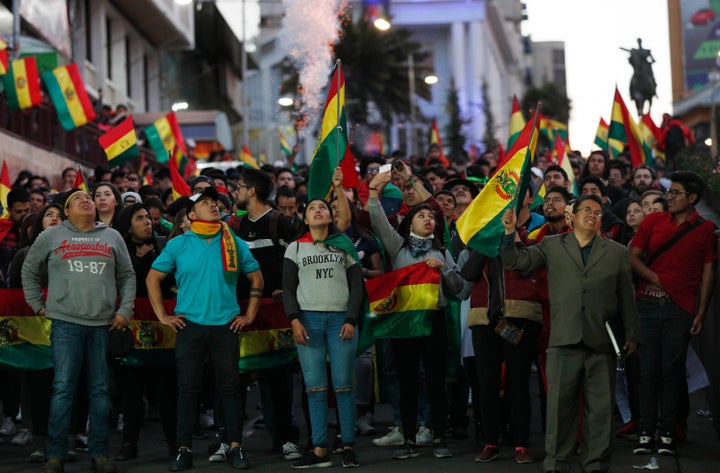WASHINGTON — When Bolivia’s socialist president, Evo Morales, stepped down last week after nearly a month of sometimes violent protests over a disputed October election, it was right-wing opposition leader Luis Fernando Camacho who declared victory.
“Today we won a battle,” Camacho, a businessman who came seemingly out of nowhere to lead the charge against Morales, told Reuters. “Only when we can be sure that democracy is solid, then will we go back home.”
Bolivians and international observers have debated whether the president was the victim of a coup, as he asserts, or a popular uprising, as his opponents and even some of his former supporters claim.
But in the week since Morales fled the country he led for 14 years amid pressure from the armed forces, Camacho and a cadre of previously unknown conservative leaders have seized on popular unrest to assert control over Bolivia’s transitional government, providing a clear picture of what their version of “solid democracy” looks like.
And it’s not democratic at all.
“It was a democratic protest with a view toward new elections, and it got seriously co-opted by an extreme right wing that didn’t follow any of the rules,” said Linda Farthing, a journalist and researcher who is based in Bolivia.
Camacho, a lawyer and businessman with previous ties to far-right extremist groups, was barely known across Bolivia before he emerged as a key opposition figure during this year’s elections, and especially after declarations of fraud during the Oct. 20 vote sparked nationwide protests. He has not taken a place in the transitional government, but he has remained a powerful figure: Camacho, a Christian, stood alongside Jeanine Áñez, a conservative Christian senator, on Wednesday as she declared herself Bolivia’s interim leader while carrying an oversized Bible into the presidential palace.
Since then, Áñez has promised to “pacify” Bolivia and put the Andean nation on the path to new elections. But she has acted as if she wants to govern, and she and her allies have wasted little time in proving that their image as restorative democrats was nothing more than a facade.

Áñez has stocked her Cabinet with right-wing figures who have accused political opponents and reporters of committing “seditious acts” worthy of official punishment. She has guaranteed the military impunity in its dealings with protesters ― even amid accusations that the armed forces and police have violently suppressed demonstrations and killed poor workers who oppose the new government. And over the weekend, her government suggested it may prosecute members of opposition parties ― Morales’ Movement for Socialism, or MAS, in particular.
Áñez, who previously tweeted bigoted messages about Indigenous people, together with Camacho, has ignited racist backlash from Bolivians angry that poor and Indigenous Bolivians made strides during Morales’ time in office.
To a democracy that needed maintenance, the right-wing has taken a bulldozer, and even if it does move toward new elections now, it has acted like the authoritarian regime it accused Morales of forming. This has created the sort of violent and chaotic atmosphere in Bolivia that has proven prosperous for the far-right recently not just in Latin America but across the world.
It was a democratic protest with a view toward new elections, and it got seriously co-opted by an extreme right wing that didn’t follow any of the rules.
Linda Farthing, journalist and researcher based in Bolivia
Camacho has drawn inspiration from Jair Bolsonaro, the far-right president of Brazil who fanned the flames of racism and bigotry and rode anger over political corruption to victory in presidential elections in that country last year.
“Camacho in particular has taken advantage of the rejection and the disaffection even among Evo supporters to convert the protests to their own ends,” said John Walsh, a Bolivia expert at the Washington Office on Latin America. “Camacho and the more extreme fringes are not representative, but they are driving the opposition’s demands and generating the energy in the streets and the sense of no restraint.”
“He has taken almost masterful advantage,” Walsh said, “with the massive risk that his take-no-prisoners brand is a recipe for catastrophe for Bolivia.”
The First Indigenous President
Morales, initially elected in 2005, turned Bolivia away from the neoliberal policies it had embraced after its return to democratic rule in the 1980s and 1990s.
Morales slashed Bolivia’s poverty rate in half and rode a global commodities boom that boosted the economy of what had long been South America’s poorest nation. In Bolivia’s western Andean highlands, Morales’ movement inspired a renewed embrace of Indigenous identity and power in Bolivia, where Indigenous people, despite making up more than half the population, did not gain the right to vote until 1952. Indigenous rights were not formally recognized until 1993.
Camacho, a lawyer and businessman, hails from Santa Cruz de la Sierra, the Bolivian financial hub in the eastern part of the country that is home to the bulk of the country’s mestizo and Spanish-descendent population, as well its financial and business elites.

Morales’ rise inspired a backlash in the east that was, at times, fueled by decidedly right-wing and racist views and even separatist politics. Santa Cruz has long been home to some of the country’s most fringe right-wingers, and in the early 2000s, Camacho was a member of a nationalist movement and an extremist far-right youth group. Human rights groups have previously said that the Civic Committee of Santa Cruz, the organization Camacho leads, is one of the “main promoters” of “racist discourses” in Bolivia.
As Bolivia prospered under Morales, popular opposition never took root: Morales overwhelmingly won a second term in 2009 and a third five years later.
It was during his third term, which was set to expire in January, that the mood began to change. Under the constitution Bolivia adopted in 2009, Morales was term-limited ― but in 2016, he put forth a referendum asking Bolivians to approve a reform that would allow him to seek another term this year. Voters narrowly rejected the referendum, but in early 2017, Bolivian courts overturned the result on grounds that term limits violated Morales’ human rights. Morales, who had pledged to respect the result in 2016, decided to run again ― a move that turned many Bolivians against him.
“At that moment, I was against him completely,” Juan Carlos Cespedes, a self-described socialist from La Paz, said as he participated in a protest against Morales outside the White House on Sunday. “People were asked if they wanted him to remain in power, and they say no. He believed, ‘It’s my right to be elected again, so that’s it, I’ll be elected again.’”
A Disputed Election Leads To Protests
Still, heading into October’s elections, most polls showed Morales running ahead of former Bolivian President Carlos Mesa, a centrist and his closest challenger. But polling also suggested Morales could fall short of either a clear majority or the 10-point victory needed to avoid a runoff, in which a unified opposition may have been able to defeat him.
On election night, voting totals showed Morales short of the threshold to avoid a second round of voting when the electoral tribunal’s public count suddenly went offline. When it returned nearly 24 hours later, Morales had cleared the necessary hurdle and declared himself the victor.
People were asked if they wanted him to remain in power, and they say no. He believed, ‘It’s my right to be elected again, so that’s it, I’ll be elected again.’
Juan Carlos Cespedes, Morales opponent
Protests erupted across the country and grew after election officials declared Morales victorious. Mesa and his supporters cried foul, and the Organization of American States, the regional body of governments from across the Americas, refused to certify the results.
Although Morales attempted to paint the protests as driven by right-wing opponents of his Movement for Socialism party, MAS, they were ideologically diverse and included many of his own former supporters.
The frustration fueling the demonstrations had not begun with the allegations of fraud, leftist Uruguayan writer Raul Zibechi argued, but “with systematic attacks” from Morales and his vice president “against the same popular movements that brought them to power, to the point that when they needed the movements to defend them, the movements were deactivated and demoralized.”
Extractivist environmental policies and deals Morales made with agribusiness interests had eroded support among some Indigenous groups. Some leftist and Indigenous leaders also became tired of Morales’ increasingly autocratic tendencies, including his efforts to suppress opposition from his own supporters and his attempts to roll back press freedom.
“There are some people who still have the idea that Evo Morales and his party, the MAS, are from the left,” said Diego Cuadros, who served under Morales during his first term but is now critical of him. “Nothing is more wrong.”

After Morales’ first term, Cuadros said, he “allied to the great interests of landowners, industrialists and banks.” And while Morales presented himself internationally as an ardent critic of U.S. imperialism and as a defender of Indigenous rights and Bolivia’s environment, he has “divided and repressed [Indigenous people] and overwhelmed the country’s natural reserves,” Cuadros said.
But this was, in the eyes of many of Morales’ leftist critics, a squabble between various left-oriented factions, not a traditional battle between the political left and right.
Right-wing figures like Camacho, however, quickly moved to the forefront and almost immediately began infusing the demonstrations with more extreme notions. While Mesa and the OAS called for the election to proceed to a runoff, for instance, Camacho and his allies demanded Morales’ immediate resignation and totally new elections.
Outbreaks of violence during the protests fueled chaos: Anti-government demonstrators targeted the homes of MAS politicians and even dragged one of the party’s mayors through the streets and cut her hair. They also accused Morales and the government of fostering violence after homes of opposition leaders were also destroyed, and especially when police allegedly shot and killed a student protester. Misinformation spread rapidly across social networks. Allegations of who was to blame for the worst violence flew just as quickly.

The protests escalated last weekend, after the OAS released a preliminary audit that it said showed “serious irregularities” in the election. Morales immediately promised to form a new electoral tribunal and hold new elections. But Camacho’s wing of the movement insisted that the president had to resign and helped foster the belief that Morales had blatantly stolen the election.
Scrutiny was warranted, but the suggestion that Morales had totally rigged the race was exaggerated: Hardly anyone questioned that the incumbent president had still earned more votes than anyone else — the original dispute was over whether he’d cleared the runoff threshold.
But Camacho’s efforts to move the goal posts worked, helping to turn a movement with legitimate concerns into a crusade driven by its most radical elements ― even as Camacho and his allies remained focused on increasing the sense of “anti-Evismo” in the protests rather than by pushing their own aims explicitly. That could wait.
There were some things that weren’t right. But it was supposed to be done a different way. We are a democracy, but this is not democracy.
Juan Carlos Cadima, Morales supporter
The first sign that the protests might achieve their primary goal came when police in multiple cities joined in the demonstrations; reports have suggested that Camacho helped persuade them to do so. Then, last Sunday, the leader of the armed forces asked Morales to step down. (The military wasn’t alone: Fearing more violent outbreaks, leaders of some Indigenous groups and top labor organizations also begged Morales to yield.)
Hours later, Morales announced his resignation. Top leaders from MAS, including Morales’ vice president and the presidents of both chambers of the legislature, joined him, citing concerns for their safety. Morales called his departure a coup, and the speed of the ouster enraged supporters who wondered how the demands had escalated so quickly, even as Morales had two months left on his current term.
“They say it was fraud, but they have not proven the fraud. They started saying fraud before the election,” said Juan Carlos Cadima, a 61-year-old from Cochabamba, during a protest supporting Morales that took place Sunday, just across from anti-Morales demonstrators outside the White House. “There were some things that weren’t right. But it was supposed to be done a different way. We are a democracy, but this is not democracy.”
With Morales gone, it was Camacho and the conservatives who quickly rose to fill the void he’d left behind.
“They took total advantage of this power vacuum that occurred, in order to seize state power,” said Nicole Fabricant, a Towson University anthropologist and expert on Bolivia. “People were calling for real democracy, but the images are vivid that it’s not democratic.”
The Right Seizes Control
The right’s intentions were clear even before Morales landed in Mexico, where he remains in exile.
Morales had led a primarily secular government, but the night he resigned, Camacho and a fellow Christian activist marched into the presidential palace and declared that they were returning Bolivia to Christ.
Backlash against Indigenous people, many of whom had raised their own concerns with Morales for years, began almost immediately: Hard-line Morales opponents burned the Wiphala, a symbol of Indigenous unity that Morales had established as a national symbol alongside the Bolivian flag, outside the presidential palace in La Paz. Some military and police officers cut the Wiphala off their uniforms and threw the emblems to the ground.
The rhetoric and actions of the right wing have only intensified since.

Áñez, the conservative Christian who had served as the second vice senator, declared herself interim president last Tuesday, a move leaders from the MAS declared illegitimate as they boycotted the proceedings and, in some instances, were blocked from attending by military and police units outside.
Áñez, who represents the northeast and is her conservative party’s only elected senator, has pledged to foster “inclusion and unity,” but there were no Indigenous people among her initial Cabinet selections. However, her choices did include numerous reactionaries who made it clear they intended to crack down on Morales supporters and MAS leaders.
One of them, new Interior Minister Arturo Murillo, promised to “hunt down” the Morales ally who’d previously held the same position, The Guardian reported. Roxana Lizárraga, the new minister of communications, accused “journalists or pseudo-journalists” of committing acts of “sedition” and said that the government would target them.
Murillo has since gone farther: Over the weekend, he said he would set up a special prosecutorial unit to target “subversive” lawmakers. This week, Camacho targeted foreign journalists from across the region, accusing one of communist ties because he had visited Cuba on vacation. Áñez also booted Cuban doctors from Bolivia in a move that could have drastic consequences for Indigenous people, and cut ties with Venezuela.
In the streets, reports suggest that the police and military have only become more repressive of leftist protesters challenging the new government, and on Friday, Morales supporters in the city of Sacaba accused the military and police of shooting and killing coca workers during a demonstration there.
“After 14 years, we are going back to the past, to what it used to be when I was young and we had to ask for democracy,” Cadima said outside the White House on Sunday. “It’s really sad.”
Reports from La Paz, the country’s administrative capital, showed police firing tear gas at Indigenous Morales supporters. It followed Áñez’s decree that gave the military immunity from any actions against protesters.
“The return of conservative right-wing forces, fused with anti-Indigenous evangelical Christian symbolism, threatens to run roughshod over the legitimate efforts of many Bolivian citizens to pluralize, democratize, and renovate the party system,” the North American Congress on Latin America, or NACLA, said in a statement last week that called the right’s resurgence a “particularly troubling development” for democracy in the country
Bolivia’s new right-wing leadership is out of step with the majority of Bolivians on both sides of the Morales equation: Áñez’s preferred candidate, a conservative, received less than 5% of the vote in the October elections. But it was also apparent at the dueling protests in Washington this weekend. Demonstrators on each side ― most of whom had, at some point, voted for Morales ― insisted that all they wanted were free elections and a legitimate democratic government. Each seemed to hold out hope that those elections were imminent, and that Áñez and the far right would cease to be factors once they occurred.
But each day that passes seems to move Bolivia closer to the brink, especially with a right-wing faction in power that has a limited traditional electoral base. Morales, meanwhile, has promised to return to the country, and even if he has said he won’t run in new elections, his presence ― and threats from Áñez that he could face criminal charges of election fraud ― could only further inflame the situation.
“The international community has a critical role to play in helping to restore calm and ensure the path to credible elections,” said Walsh, from the Washington Office of Latin America ― but thus far, a bitter and divided hemisphere has done little to help ease the tensions.
Recent history, meanwhile, suggests that Camacho and his ilk may stand to benefit even if elections do occur. Figures like Brazil’s Bolsonaro have prospered by turning demands for better, more democratic governments into skepticism of democracy itself. They have used legitimate unrest to foster fear, chaos, hatred and violence that polarizes populations and reinforces itself. The far right has thrived, over and over again, on hate, distrust and vitriol exaggerated by its own exaggeration ― and Camacho has picked up the playbook.
Last week, as thousands of Bolivians awaited Camacho’s arrival at an event in Santa Cruz, a speaker celebrated that the country had finally rid itself of Morales. He shouted: “Satan, get out of Bolivia now!”
REAL LIFE. REAL NEWS. REAL VOICES.
Help us tell more of the stories that matter from voices that too often remain unheard.
Credit: Source link